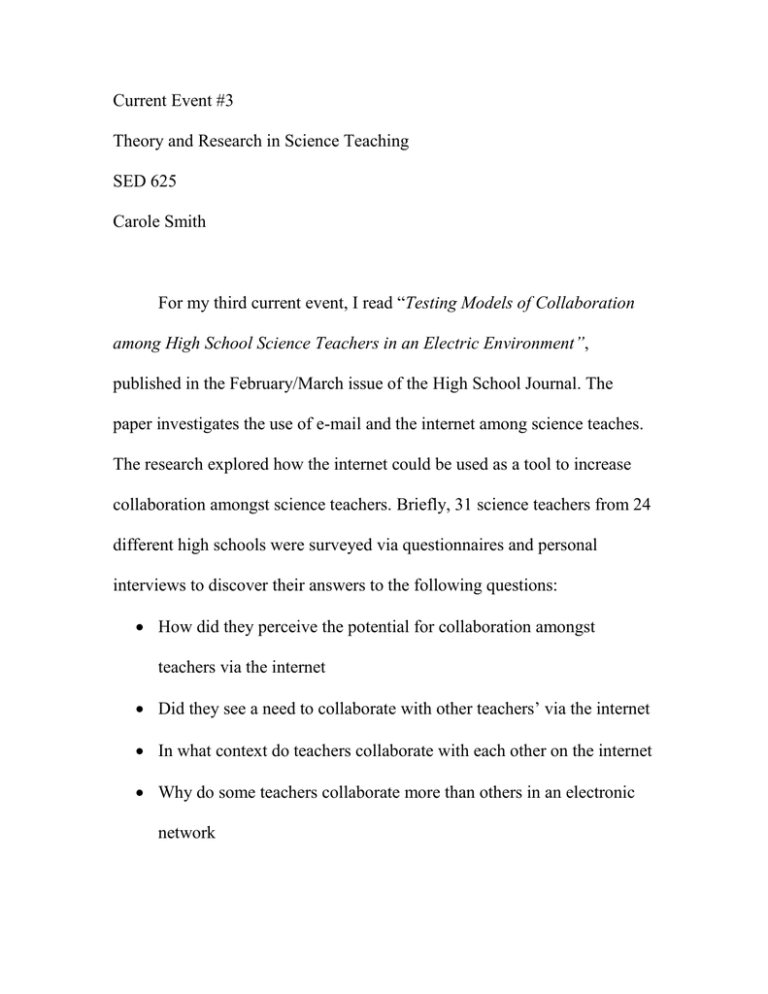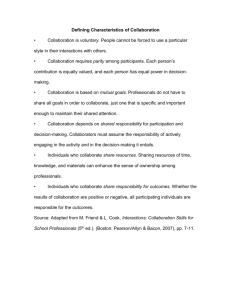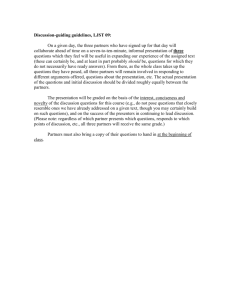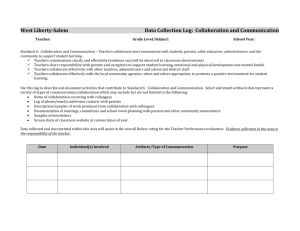Current Event
advertisement

Current Event #3 Theory and Research in Science Teaching SED 625 Carole Smith For my third current event, I read “Testing Models of Collaboration among High School Science Teachers in an Electric Environment”, published in the February/March issue of the High School Journal. The paper investigates the use of e-mail and the internet among science teaches. The research explored how the internet could be used as a tool to increase collaboration amongst science teachers. Briefly, 31 science teachers from 24 different high schools were surveyed via questionnaires and personal interviews to discover their answers to the following questions: How did they perceive the potential for collaboration amongst teachers via the internet Did they see a need to collaborate with other teachers’ via the internet In what context do teachers collaborate with each other on the internet Why do some teachers collaborate more than others in an electronic network What are some barriers to science teachers’ collaboration via the internet The researchers concluded that increasing collaboration will be a goal for schools, but that currently most science teachers rarely used the internet as a tool for collaboration and that most science teachers had negative ideas about collaboration via the internet. I chose this article to review because I was interested in its premise. Integrating technology into our teaching of science is frequently considered, but as a teaching tool rather than as a support. For example, I know how to integrate technology into teaching students how to use a pH meter with computer access, but I have not considered collaborating with other teachers as to best teaching practices for this topic. Unfortunately, I was very disappointed with this article. My main criticism of it is the very small sample size of the research pool. As mentioned previously, 31 science teachers were surveyed from 24 different schools. However, only teachers from 16 schools responded to the survey, so the pool of teachers for data collection was even less. Given that in California alone there are more than 13,000 schools, their sample size certainly does not seem to be a fair representation of the educational community. For example, their research shows that “most science teachers are almost never involved in a team for instructional improvement (71%) … or develop teams with other teachers to support professional growth improvement (71%).” At the school that I teach at, Palisades Charter High School, nothing could be further than the truth – we are all active participants in a variety of different committees and educational programs designed to increase student achievement. With the latest educational theorist suggesting the “small learning communities” model, I am sure that my school is no different from many others. Their research could have been improved upon by collecting data from more schools. Additionally, their research focused on the answers to a relatively small amount of questions, 24 with only one being short answer. It hardly seems good research, or even a fair indication of science teachers, to look at such a few amount of teachers with only a handful of questions. Another criticism that I have of this article is that the majority of the article was focused on how the research was conducted and data collected than on its implications. I understand the value of illustrating their intent and methods, but feel that it took away from the educational value of the article. Their research could have been improved upon by collecting data from more schools and their article improved upon by being more thoughtful about their results and its implications. Despite these drawbacks, the article did raise several good points for educational theorists to consider. The internet has the potential to be a powerful tool in increasing teacher collaboration, mentoring, team teaching, and sharing of resources. I was interested to learn that most of the science teachers that participated in the survey were males, and that overall more men rated themselves as being comfortable with technology. I found this an interesting illustration of one of the differences in male and female learning styles that was not mentioned in the first two chapters of “Boys and Girls Learn Differently”. I was also surprised to learn that most teachers surveyed strongly disagree about collaborating with teachers on the internet that they had met face-to-face, but again, due to the studies small sample size this may not actually be the case if the research had been expanded. I found this article useful in the possibilities that it explored. I certainly would be eager to collaborate with others via the internet to learn best teaching practices and share information. A limitation that I see is finding the other teachers to collaborate with. Part of the reason for my enrolling in the science cohort at CSUN is for that very reason – I enjoy, and thrive, upon sharing and learning from others. I believe that the internet could be a dynamic pathway for teacher collaboration, but lack some of the technology skills to fully utilize it at the moment. I am interested in how other teachers would feel about this issue and will bring it up at my next science department meeting, as well as the next district wide chemistry teachers meeting and, if possible, a conference I am attending next week.





